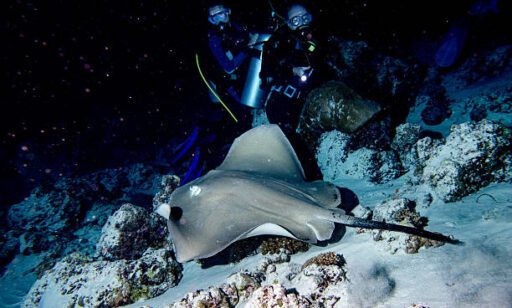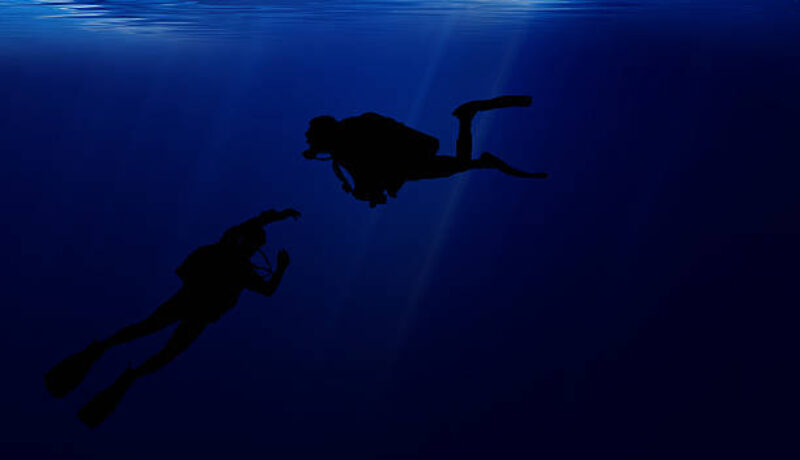SSI Night Diving Course & Limited Visibility Specialty
Summary: In this blog, we will discuss the SSI night diving course & limited visibility, theory and practical exercises, night dive skills, eligibility, course price and duration.
The diving sessions don’t end when the sun goes down. You should pick the SSI Night diving course to witness the incredible marine life that comes out only at night for hunting. SSI night dive & limited visibility program is specially designed to increase your knowledge base, learn different skills, and of course experience different marine life.
Multiple species of sea animals keep themselves hidden in corals during the day and are active when it’s getting dark. Some ocean creatures begin their hunting during the night such as lobsters, octopuses, morays, rays, and species of barracudas or sharks. You need to learn different skills along with equipped specific types of equipment to dive at night or in limited visibility conditions.
Diving into the deep black water during the night is a completely unique experience. It may be unfamiliar or a bit difficult during the first-night dive, but you will get used to it and love it after a couple of dives.
Limited visibility is another important factor that may severely affect your dive experience or mislead you. High water currents and sea waves usually disrupt the sand which leads to low visibility. The visibility may go down for a few meters or even centimeters. In such situations, it is essential to move on the right path and communicate or react with your buddy.
The night diving and limited visibility specialty course are basically divided into two parts.
- Theoretical training sessions
- Practical training sessions
Theoretical training sessions
A diver must have to prepare theory lessons before starting a night scuba dive specialty course. Theoretical case studies are online available and after registration, you can get access to it. It is the best way to prepare your course theory before visiting your diving destination. It is useful to save time for limited-time travelers.
Required Skillset for night diving or limited visibility course
Underwater Navigation
It is an important diving skill and helps you to navigate in the right direction underwater. A dive compass is helpful to measure your direction during sea navigation. A dive computer is useful to measure your underwater dive depth. Perfect underwater navigation skill matters while diving in a no-visibility environment. It saves you from getting lost in the water and assists you in showing the exact path. Underwater navigation is an important skill for your SSI night diving course to perfectly navigate in night dive conditions.
Perfect Buoyancy
It is another important diving skill to manage your body weight perfectly underwater. BCD & Weight belts are useful pieces of equipment to maintain your buoyancy. A diver’s body must be in proper horizontal position and his knees must bend 90 degrees and his fins must point backward. During buoyancy, it is a must to balance your weight and center gravity around your navel. It will help you to don’t let your knees down and prevent your head from pointing downwards.
Tips to improve your underwater buoyancy
- Measure and weight yourself correctly
- Adjust weight according to dive equipment and conditions
- Keep your body in perfect positioning
- Introduce yourself with your BCD
- Practice breath control skills
- Don’t use your hands while underwater buoyancy
Torch signals
During your night dive, you have to carry two torches for safety purposes and keep your main torch turned on before entering the water. you have to light your torch downwards while descending and light the torch upwards while ascending to make sure there is no obstacle below or above you. You can move the direction of the torch towards your chest to see the darkness underwater.
Practical training sessions

After completion of the theory part, now starts the practical part which is definitely the most fun part of the course. After a brief discussion of your theoretical knowledge, it’s time to get into the water to practice your theory sessions. The course includes 2-night dives, it’s going to be a crazy feeling at first dive and you will get used to it after a while.
It is important to find your buddy when the torch is switched off during the session of your night dive. One of the instructors will swim a few meters away from you. You have to find the instructor while pointing the direction of the torch towards your chest. The exercise is easy to complete and is intended to find your buddy in case the torch is switched off. Torch beam will be helpful to find your buddy provided you swim in range.
Equipments and Precautions for night diving
A diver must have proper dive lights for night diving and adequate protection from body exposure. A night diver must carry two dive lights (primary and backup), a compass, a marker buoy, a slate, and other devices. Underwater navigation, perfect buoyancy, and torch signals are essential skills for the night diving specialty program.
A night diver must adhere to extra precautions and skills for night dives including:
- It is a good practice to avoid shining the torchlight in other diver’s eyes.
- A night diver must be aware of surface light signals and use bearings or illuminated shotline buoy.
- A surface marker buoy with an attached strobe light or cyalume stick is useful to indicate divers position to the surface team.
- There is the potential risk using a strobe light by a diver underwater can damage the night vision of other divers.
Possible hazards of night diving
Scuba diving at night inherent additional risks, challenges, and skills compared to diving during the day. Failure of dive lights, disorientation, limited visibility, and encounters with nocturnal marine life might make night diving more challenging. A night diver can avoid potential night diving risks and find it a more rewarding and exhilarating experience by practicing proper training, equipment, and preparation.
1. Failure of dive light
Failure of the dive light is the major night diving hazard when diving in darkness. Subsequently, it might result in losing vertical visual references and being unable to control depth or buoyancy. It further disrupts reading instruments such as dive computers, compass, and dive cylinder contents gauge, and risk of separation from the rest of the diving group, boat, or shore cover. Backup lights are always recommended to avoid such circumstances.
2. Limited visibility
Limited visibility plays a significant role during night dives which makes it harder to navigate or communicate with your dive buddy. It is essential to maintain close proximity with your dive buddy and use proper dive lights to avoid the risk of getting separated.
3. Marine life behavior
Some Nocturnal marine animals become more active at night such as octopuses, lobsters, Bluntnose stingrays, and certain types of fish. It is a good opportunity to witness the behavior of Nocturnal marine animals but the proximity of unpredictable encounters can’t be sidelined. This is because some marine animals might be more defensive or territorial at night. It is a good practice to maintain extra precautions and respect their space.
4. Disorientation
There is a potential risk of disorientation during night dives or limited visibility conditions especially if you heavily rely on visual references. It is easier to become disoriented and lose your sense of direction while diving into unfamiliar landmarks or clear visual cues. The risk of disorientation can be avoided by the application of good navigation skills, use of a compass, and other navigation tools.
5. Increased risk of entanglement
Night diving makes it more difficult to identify potential hazards such as ropes, fishing nets, or lines that increase the risk of entanglement. It is a good practice to stay aware of your surroundings, maintain good buoyancy control, and avoid touching or disturbing the marine environment.
6. Equipment failure
Equipment malfunctions can happen at any time whether you’re diving in a day or night but addressing the issue might be more challenging in the darkness. It is essential to use well-maintained or functioning diving gear, pre-dive safety checks, and use of reliable dive lights.
Eligibility criteria for SSI night diving specialty
A person must be at least 12 years old and have completed an open water certification program to join the Night diving & limited visibility specialty course. The person must be physically and mentally fit enough to dive and know basic swimming.
Suggested Read: Wreck Diving Specialty Course
Price and duration of the program
Course fees
Night dive specialty course fees depend on the location wise where you dive in. The course fee for the night diving program in Andaman is INR 14000 (excluding tax) per person for 2 consecutive night dives. Pick-up and drop-off facilities are complementary by non-AC cars.
Duration
A night diver student must spend at least 2 full days completing his/her night diving specialty program. The actual dive time per night dive is 45 minutes underwater and Nemo Reef is the dedicated dive site for night dives in Havelock Island. The estimated time per night dive (including theory & practical sessions) is 3-4 hours. Practical night dive sessions start as soon as the sun goes down and the maximum allowable depth is 8-12 meters.
